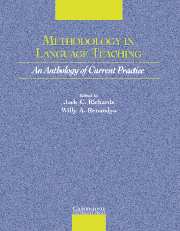Book contents
- Frontmatter
- Contents
- Acknowledgments
- Introduction
- Section I Approaches to Teaching
- Section 2 Lesson Planning and Classroom Management
- Section 3 Classroom Dynamics
- Section 4 Syllabus Design and Instructional Materials
- Section 5 Task and Project Work
- Section 6 Learning Strategies
- Section 7 Teaching Grammar
- Section 8 Teaching Pronunciation
- Section 9 Teaching Speaking
- Section 10 Teaching Listening
- Chapter 21 Listening in Language Learning
- Chapter 22 The Changing Face of Listening
- Chapter 23 Raising Students' Awareness of the Features of Real-World Listening Input
- Section 11 Teaching Vocabulary
- Section 12 Teaching Reading
- Section 13 Teaching Writing
- Section 14 Assessment
- Section 15 Technologies in the Classroom
- Section 16 Professional Development
- Credits
- Author Index
- Subject Index
- References
Chapter 23 - Raising Students' Awareness of the Features of Real-World Listening Input
Published online by Cambridge University Press: 10 November 2010
- Frontmatter
- Contents
- Acknowledgments
- Introduction
- Section I Approaches to Teaching
- Section 2 Lesson Planning and Classroom Management
- Section 3 Classroom Dynamics
- Section 4 Syllabus Design and Instructional Materials
- Section 5 Task and Project Work
- Section 6 Learning Strategies
- Section 7 Teaching Grammar
- Section 8 Teaching Pronunciation
- Section 9 Teaching Speaking
- Section 10 Teaching Listening
- Chapter 21 Listening in Language Learning
- Chapter 22 The Changing Face of Listening
- Chapter 23 Raising Students' Awareness of the Features of Real-World Listening Input
- Section 11 Teaching Vocabulary
- Section 12 Teaching Reading
- Section 13 Teaching Writing
- Section 14 Assessment
- Section 15 Technologies in the Classroom
- Section 16 Professional Development
- Credits
- Author Index
- Subject Index
- References
Summary
INTRODUCTION
Many learners of English encounter more difficulties in listening and speaking than in reading and writing. One of the contributing factors is that much emphasis is laid on the written text in the teaching syllabus. The effect is that young learners start learning the written form of the language with little regard to its aural-oral aspect. When listening to natural, unscripted speech, students are exposed to loose, flowing texts. On the other hand, when reading, they are exposed to dense, structured texts. Many teachers fail to highlight this difference to the students and subsequently the teaching and learning of listening and speaking skills can only achieve minimal results.
Even when the aural-oral aspect is dealt with, the symbiotic relationship between listening and speaking practices is often overlooked. In many real-life situations, listening is reciprocal. The listener has the opportunity to indicate understanding or nonunderstanding, and to intervene when clarification is needed during communication (Anderson & Lynch, 1988). As listening and speaking are part and parcel of the spoken language, I would therefore argue that any effective listening course should help learners recognize the unique characteristics of spoken language (Allison & Martyn, 1993).
In this article, I focus on the description of these characteristics and the ways to alert learners to these characteristics in order that they can cope with real-world listening input and real-life communication more effectively.
- Type
- Chapter
- Information
- Methodology in Language TeachingAn Anthology of Current Practice, pp. 248 - 254Publisher: Cambridge University PressPrint publication year: 2002
References
- 5
- Cited by



